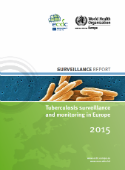Tuberculosis surveillance and monitoring in Europe 2015

Download
This is the seventh report launched jointly by the European Centre for Disease Prevention and Control (ECDC) and the WHO Regional Office for Europe following on from reports under the EuroTB project, established in 1996.
An estimated 360 000 Europeans developed tuberculosis (TB) in 2013 – 1000 people on a daily basis. According to new data published today by the European Centre for Disease Prevention and Control (ECDC) and the WHO Regional Office for Europe, the number of TB cases dropped by about 6% compared to 2012, continuing a sustained decline over the last decade across the Region. But rates of multidrug-resistant (MDR) TB remain at very high levels, particularly in the so-called 18 high-priority countries, which see 85% of all new TB cases in the Region. These countries also account for most of the 38 000 TB-related deaths in 2013.
In collaboration with national and international partners and civil society organizations, the Regional Office has been implementing the MAP and helping countries to adopt evidence-based interventions so as to improve the prevention and control of TB. The Regional Office has also established the European Green Light Committee and the European Laboratory Initiatives to help countries develop and/or adjust their national plans in response to the threat from M/XDR-TB. The MAP is in its final year of implementation. European Member States, the Regional Office and partners are developing a new TB Action Plan covering the period 2016–2020. This Action Plan builds on the progress made during the implementation of the MAP and is in line with the global End TB Strategy and other health policy guidance, such as Health 2020: the European policy for health and wellbeing. With its partners, the Regional Office supports European countries in their work to prevent and control TB and M/XDR-TB. This includes setting norms and standards, providing technical assistance, fostering partnerships, building capacity, creating and disseminating evidence, and conducting monitoring and evaluation.



